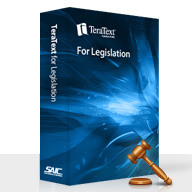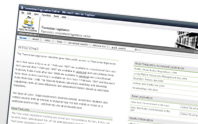
TeraText® for Legislation
TeraText for Legislation adds a set of tools to the Document Management System to help manage and automate the process of drafting and publishing legislation.
Overview
TeraText for Legislation adds a set of tools to the TeraText Document Management System (DMS) to help manage the process of drafting and publishing legislation and governments (including Canada, Australia, and Papua New Guinea) manage and even automate many of the drafting and publishing steps for these highly important documents. This tool set is the basis of the highly successful EnAct® system deployed in Tasmania and Papua New Guinea, the Legislation Information System (LEGIS) system deployed in New South Wales and the Australian Federal Parliament, and the Legislation Editing and Authentic Publishing (LEAP) system being developed for the Singapore government.
Amendments to Legislation
An important characteristic of legislation is that it changes over time. Amendments, sections or even larger units can be added, removed or altered. Although new laws are created, more often existing legislation is altered or amended. This must be done by creating amending laws with specific editing instructions, perhaps changing the wording of one or two sections, or replacing complete sections, or even removing or inserting whole parts or chapters.
Legislation's Temporal Nature
Although only the original law and the amending laws have legal force, lawyers and legal researchers need access to the law as it was during the time period relevant to their particular problem. From time to time, governments authorize an agency to issue publications that consolidate particular laws. These consolidations include codes, reprints, and revisions. A consolidation represents current law, presenting the law as modified by all relevant amending laws — with all additions, deletions, and changes to wording applied, and with all new components inserted. However, lawyers are often interested in the state of the law at times other than those for which officially released consolidations are available. Ideally, they would like to access consolidations of the law at any and every arbitrary point in time.
Key Challenges
A number of key challenges exist in delivering an effective legislative management system:
- Representing and maintaining the structure inherent in legislative documents
- Providing the ability to search legislation databases at an arbitrary point in time
- Certain legislative and regulatory procedures are rigid and strict compliance is required for a document to be accepted as valid law (e.g. a Bill must be read three times in each chamber, and a Bill must pass a majority in each chamber).
- Numerous events and activities relating to Bills are optional and can take place at multiple stages during the law-making process (e.g. committee hearings, accepting or rejecting proposed amendments).
- The legislative environment presents an unusual mixture of important and highly public documents, highly sensitive confidential documents, and the security requirements for managing the content and status of both types of documents can be complex.
Representing Structure With XML
The use of XML solves the problem of how to represent the structured text inherent in legislation. XML defines an abstract grammar for representation and exchange of text with tags interspersed throughout the text. A DTD (document type definition) is a particular XML grammar describing which document components are valid and what sub-components the document can contain. Bills or resolutions from a given jurisdiction can be stored in XML in a format satisfying a particular structural requirement (i.e., every bill must contain sections and each section must contain text, or two or more subsections, and so on). One would then describe how to display a particular bill that satisfied the structural requirement by describing the presentation in terms of the DTD. A number of different presentation schemes can be described for a single DTD so that one might specify a presentation that only displays the table of contents to a specified depth as well as a presentation for the whole bill or resolution. This is one of the advantages most often cited for using XML: the ability to reuse the same information for multiple purposes.
Supporting Point-in-time Search
TeraText for Legislation augments the TeraText DMS with tools to help automate the drafting of amendments in such a way that the creation of amending laws and the production of various types of consolidation of those amending laws can be largely automated. When the workflow process completes the enactment or making of a law, the consolidation process applies the amendments to produce a new consolidated version of the text.
Whether these tools are used (as in EnAct) or a manual consolidation process is applied (as in LEGIS), TeraText for Legislation uses the TeraText DMS and the TeraText Database System (DBS) to present these consolidations, allowing users of the law to search and browse the entire collection of laws as they were at a particular time. Accessing databases of laws does not involve only viewing text. Collections of laws contain large number of interrelated documents ideally linked by hyperlinks. Viewing a consolidation of laws at a particular point in time involves retrieving the correct text as well as the correct hyperlinks at one time.
Example Site: Tasmanian Legislation
This site gives free public access to the Tasmanian Legislative Acts in consolidated form. This site also features advanced searching and browsing capabilities with all cross-references and amendment history stored as electronic hyperlinks.
Managing Legislative Process
Managing the legislative process requires an extremely flexible workflow and metadata management platform to support a mixture of rigid and ad hoc events and tasks associated with a single Bill or a set of related Bills, a flexible document versioning environment, and an intimate understanding of the legislative process with strong security credentials to ensure appropriate security is applied.
TeraText for Legislation supports Bills before the legislature as Projects. The metadata, lifecycle stages, and business rules of a Project are configured in a Workflow Process Definition. In addition to the more rigid process rules, TeraText for Legislation also captures events – for example, an amendment motion or a committee hearing. Events can accurately capture process details – such as the date of a committee hearing or the resulting report - that can repeat, or can occasionally happen in different orders (for instance, proposed changes from one chamber may be referred back to the responsible Standing Committee in the other chamber after their initial report has been presented at second reading), without losing or overwriting data fields. Events can also be linked to specific versions of a document allowing tracking of which documents are actually used for various purposes. Each document or document version can be associated with one or more other documents, document versions, events or processes.
The web-based interface to these processes and events can be customized for different users, roles or responsibilities. A simple web report interface allows authorized users to create standard and ad hoc reports over the whole repository or selected subsets.
Managing Access and Security
TeraText for Legislation is built on TeraText DBS which has a security model developed for the intelligence community supporting role-based access to data at the field, record, and database levels. This enables an administrator to restrict access to sensitive data down to the level of specific XML nodes. TeraText for Legislation can manage high-performance access to public documents, restrict access to confidential documents to authorized users, and move documents automatically between repositories dedicated to public or private access as required. Access to change the content or status of a document is restricted to authenticated and authorized users. What a user is authorized to do with a document depends on the roles of that user, the workflow status, metadata stored in or with the document or document version (such as the date of tabling, or the date for public release), and metadata associated with the workflow (such as the type of Bill, the sponsor, the assigned standing committee, etc). Other security features include support for Lightweight Directory Access Protocol (LDAP) and Active Directory, the Generic Security Service (GSS), and Secure Sockets Layer (SSL) to handle encrypted sensitive information.
An Ideal Partnership
TeraText for Legislation provides a number of tools that augment the underlying TeraText DMS and DBS capabilities with the ability to provide accesses to the correct state of the law at any point in time. By using XML to represent the structured text inherent in legislation, TeraText for Legislation solves the challenge of maintaining a consistent structural representation for the documents, while allowing the database designer to reuse the same information for multiple purposes. By using a combination of XML and sophisticated search and indexing capabilities, TeraText DBS effectively and efficiently supports point-in-time access to legislation. The TeraText DMS provides powerful fragmentation capabilities, allowing large pieces of legislation to be managed both as whole documents and as individual components, such as separate sections, to be versioned independently of the whole document. A combination of flexible and rigid workflow capabilities and a robust security environment provides a powerful platform for a variety of solutions in the legislative and regulatory environment.
Leidos has over 15 years experience developing solutions for the legislative environment using this platform and can provide a cost-effective application customized to each jurisdiction's requirements.
Download White Papers
Learn how TeraText for Legislation can help manage the process of drafting and publishing legislation.
Example Site:
Tasmanian Legislation
This site provides access to Tasmanian Legislative Acts with advanced searching and browsing capabilities. View the site »

